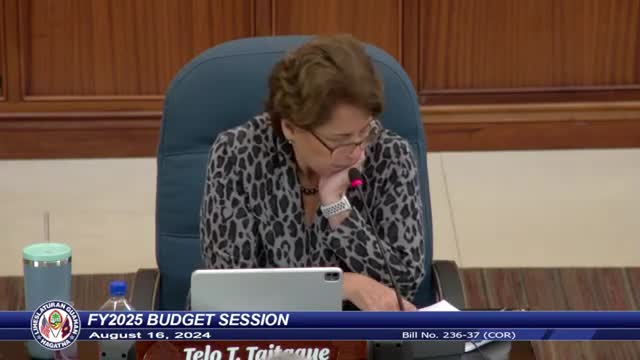Budget Oversight Sparks Urgent Call for Cancer Funding
August 16, 2024 | General Government Operations and Appropriations , Legislative, Guam

This article was created by AI summarizing key points discussed. AI makes mistakes, so for full details and context, please refer to the video of the full meeting. Please report any errors so we can fix them. Report an error »

During a recent government meeting, significant discussions centered around budget allocations and funding for various departments, particularly in relation to the unified judiciary operations and health services.
A notable point of contention arose regarding an error in the budget for unified judiciary operations, which was initially reported as unbalanced by $889,318. Officials clarified that this discrepancy was merely an oversight and that the funds were fully accounted for, alleviating concerns about excess funds being unallocated.
Senators expressed urgency in addressing funding for the cancer foundation at the University of Guam, highlighting a consistent failure to meet the legal requirement of allocating 15% of funds to cancer-related initiatives. One senator emphasized the need for increased support, citing numerous fundraising events for cancer treatment that have not translated into adequate financial backing from the legislature.
The meeting also addressed a substantial increase in the budget proposed by the governor, amounting to $48 million for fiscal year 2024, with an additional $46 million added by the Office of Finance and Budget (OFB). This raised questions about the specific allocations of these funds. Officials detailed that the increases would support various sectors, including public health, behavioral health, and operational costs for the Guam Memorial Hospital.
Concerns were raised regarding the Healthy Futures Fund, which is projected to face a shortfall of approximately $14 million by the end of the fiscal year. The anticipated collections for the fund in fiscal year 2025 were adjusted down to $23 million, reflecting a cautious approach given current trends. This adjustment has implications for funding allocations, particularly for Guam Behavioral Wellness, which is expected to receive $6.1 million from the general fund instead of special funds.
Overall, the meeting underscored the complexities of budget management and the pressing need for transparency and accountability in funding allocations, especially in health services that directly impact the community.
A notable point of contention arose regarding an error in the budget for unified judiciary operations, which was initially reported as unbalanced by $889,318. Officials clarified that this discrepancy was merely an oversight and that the funds were fully accounted for, alleviating concerns about excess funds being unallocated.
Senators expressed urgency in addressing funding for the cancer foundation at the University of Guam, highlighting a consistent failure to meet the legal requirement of allocating 15% of funds to cancer-related initiatives. One senator emphasized the need for increased support, citing numerous fundraising events for cancer treatment that have not translated into adequate financial backing from the legislature.
The meeting also addressed a substantial increase in the budget proposed by the governor, amounting to $48 million for fiscal year 2024, with an additional $46 million added by the Office of Finance and Budget (OFB). This raised questions about the specific allocations of these funds. Officials detailed that the increases would support various sectors, including public health, behavioral health, and operational costs for the Guam Memorial Hospital.
Concerns were raised regarding the Healthy Futures Fund, which is projected to face a shortfall of approximately $14 million by the end of the fiscal year. The anticipated collections for the fund in fiscal year 2025 were adjusted down to $23 million, reflecting a cautious approach given current trends. This adjustment has implications for funding allocations, particularly for Guam Behavioral Wellness, which is expected to receive $6.1 million from the general fund instead of special funds.
Overall, the meeting underscored the complexities of budget management and the pressing need for transparency and accountability in funding allocations, especially in health services that directly impact the community.
View full meeting
This article is based on a recent meeting—watch the full video and explore the complete transcript for deeper insights into the discussion.
View full meeting